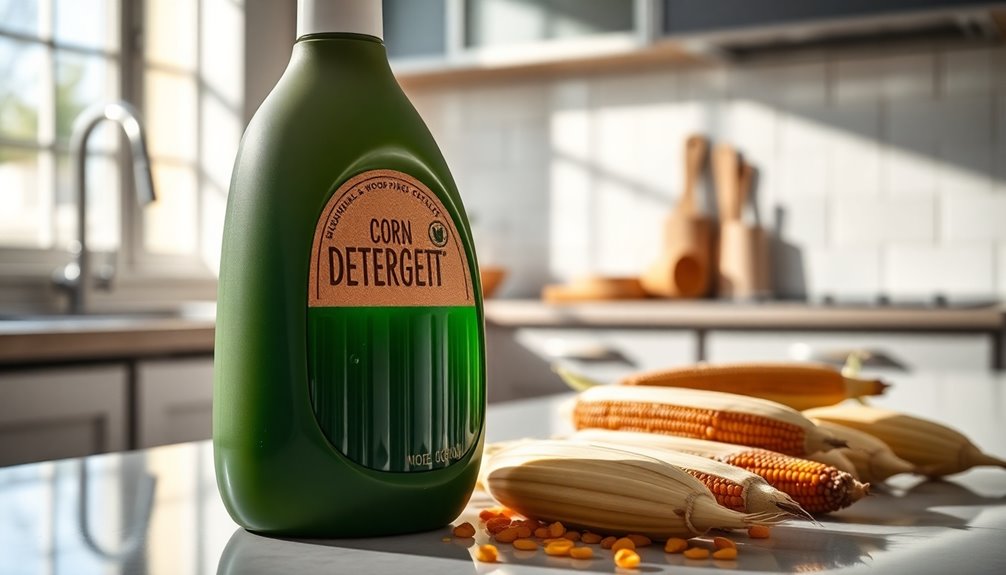A revolutionary green detergent made from sustainable wood fiber and corn protein is hitting the market! This innovative formula, packed with cellulose nanofibers and zein protein, effectively cleans various surfaces while being biodegradable and eco-friendly. It outperforms traditional options, achieving a 92% stain removal rate on stainless steel. With no harmful residues, it's safe for your fabrics too. You're going to want to stick around to discover more about its benefits and potential impact on your cleaning routine!
Key Takeaways
- The new green detergent is made from cellulose nanofibers sourced from wood and zein protein derived from corn.
- It is biodegradable and composed of renewable resources, making it an eco-friendly alternative to traditional detergents.
- The detergent shows impressive cleaning performance, achieving a 92% stain removal rate on stainless steel plates at a 5% concentration.
- Versatile in use, it effectively cleans various surfaces including fabrics, ceramics, and plastics without leaving residue.
- Its potential for lower production costs aligns with the growing demand for sustainable consumer products in the cleaning market.

As you search for effective cleaning solutions, you might want to consider green detergents that not only tackle tough stains but also protect the environment. One innovative option hitting the market is a green detergent made from cellulose nanofibers extracted from wood and zein protein derived from corn. This unique combination allows the detergent to attract and repel water, creating effective emulsions while keeping oils trapped. Developed with funding from China's Key Technologies R&D Program, this product highlights the growing commitment to eco-friendly solutions.
You'll be pleased to know that this green detergent is biodegradable and made from renewable resources, significantly reducing the environmental harm associated with traditional synthetic detergents. The research published in the American Chemical Society journal *Langmuir* shows that it not only performs comparably to commercial options but often surpasses them, especially at higher concentrations. Additionally, it represents a plant-based alternative to traditional synthetic detergents.
For instance, it shows remarkable stain removal efficiency on cotton fabrics and nearly matches commercial dish soap for cleaning dishes.
What's more, this detergent leaves no residue on fabrics after washing, indicating its gentleness on materials. It efficiently tackles various stains, including ink, chili oil, and tomato paste, and demonstrates a 92% stain removal rate on stainless steel plates at a 5% concentration.
Whether you're cleaning fabrics, ceramic, stainless steel, glass, or plastic surfaces, you can trust its performance.
Using a product like this aligns with the increasing public demand for eco-friendly consumer goods. It not only presents a competitive alternative to traditional detergents in terms of effectiveness but also offers potential economic benefits through lower production costs.
Frequently Asked Questions
Is the Detergent Safe for Sensitive Skin?
If you have sensitive skin, you might find this detergent to be a gentle option.
It leaves no residue on fabrics, reducing the risk of irritation. While individual reactions can vary, the natural ingredients are generally less likely to cause allergic responses compared to synthetic alternatives.
Plus, it rinses efficiently, which means fewer irritating substances linger on your clothes after washing.
Always do a patch test to ensure it suits your skin.
Can It Be Used in High-Efficiency Washers?
Think of your grandma's old laundry tricks—she'd love this!
You can definitely use this detergent in high-efficiency washers, but keep an eye on suds. It performs well at various concentrations, so you might need to adjust the amount to avoid foam buildup.
Its biodegradable nature aligns perfectly with your eco-friendly goals, making it a smart choice.
Just remember, testing for compatibility will help you get the best results!
What Is the Shelf Life of the Detergent?
The shelf life of your detergent can vary based on its type and storage conditions.
Liquid detergents usually last between 6 to 18 months, while powdered ones can remain effective indefinitely if kept dry.
Pod detergents typically last about six months.
To maximize shelf life, store your detergents in a cool, dry place away from sunlight.
How Should I Store the Detergent?
To store your detergent effectively, keep it away from direct sunlight and heat sources, ideally in a cool, dry place like a laundry room shelf.
Make sure the container's airtight to prevent moisture exposure, and always keep the lid tightly closed when not in use.
Store it out of reach of children and pets, and check the container regularly for any signs of damage to maintain its efficacy.
Is the Packaging Environmentally Friendly?
Yes, the packaging is environmentally friendly.
You'll notice that many brands now use recyclable cardboard and innovative designs like bag-in-box systems, which minimize plastic waste.
These materials not only protect the product but also reduce the overall environmental impact.
By choosing products with sustainable packaging, you're contributing to waste reduction and promoting eco-friendly practices.
Conclusion
In a world where sustainability blooms like a vibrant garden, this green detergent made from wood fiber and corn protein stands out as a refreshing breeze. You're not just cleaning; you're nurturing the planet with every wash. Imagine your clothes, fresh and bright, while the earth breathes a sigh of relief. By choosing this eco-friendly solution, you're painting a brighter future for generations to come, one wash at a time. Embrace the change and let nature thrive!









